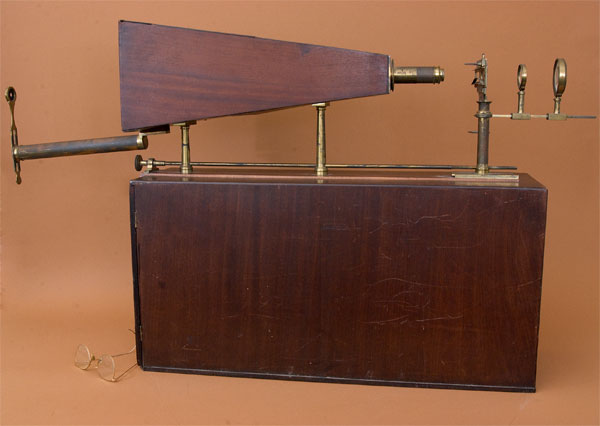 |
|||||
 |
 |
||||
 |
|||||
 |
 |
||||
W&S Jones Lucernal Microscope (No. 33) |
||||||||
 |
Age: c. 1798 Made by: William and Samuel Jones Made in: London, England |
|||||||
 |
||||||||
|
The Lucernal microscope was invented by George Adams senior (1708–1773), and is described by his son, George Adams the younger (1750–1795) in Essays on the Microscope, etc., London 1787 (p65). Adams claimed that it was of special value in assisting the preparation of a drawing. Comparing the upright compound microscope to his new lucernal microscope he wrote: "I have, however, so improved and altered it, both in construction and form, as to render it altogether a different instrument." This microscope in the Golub collection is a descendent of the horizontal design first used by the Italian microscopist, Filippo Bonanni, in the latter part of the 17th Century. Lucernal microscopes varied from rectangular boxes (an early Adams design), to brass cylinders, to the pyramidal design of the microscope in the Golub Collection. After the death of Adams the younger in 1795 the family business was carried on by William and Samuel Jones, and it is they who made this particular instrument. The lucernal microscope is basically an optical bench supported by a mahogany box, which also serves as a case for the instrument. The main body of the microscope is a pyramidal-shaped mahogany box which, upon removal from its case, can slide into position for use by means of a dovetail groove on the top surface of the case. A condenser lens system serves to focus light onto the slide. The observer positions their eye along the optic axis. Given the large size and focal length of the microscope eyepiece lens, this position is located by means of a "shade" with a target hole (shown above extending left from the instrument). When the eye is correctly placed the entire eyepiece lens is illuminated, and the magnified specimen is visualized. The illuminating system was usually an oil lamp. Specimens were held in place on the specimen holder by a spring mechanism. Focusing was accomplished by turning a thumbscrew (at the observer's end) that positioned the specimen holder at the objective end. Rack and pinion mechanisms change X and Y position of the specimen. Usually, the observer used long mahogany handles to turn these pinions. These are missing. There are three objectives with this instrument. The drawer in the bottom of the case held accessories: two additional objectives and specimen slides (six bone specimen holders for transparent plant specimens, six ebony holders for opaque specimens, two wooden holders containing insect specimens). The microscope system is approximately 65w x 20d x 65cm tall. |
||||||||
| Featured 06/2005, 05/2009 | ||||||||